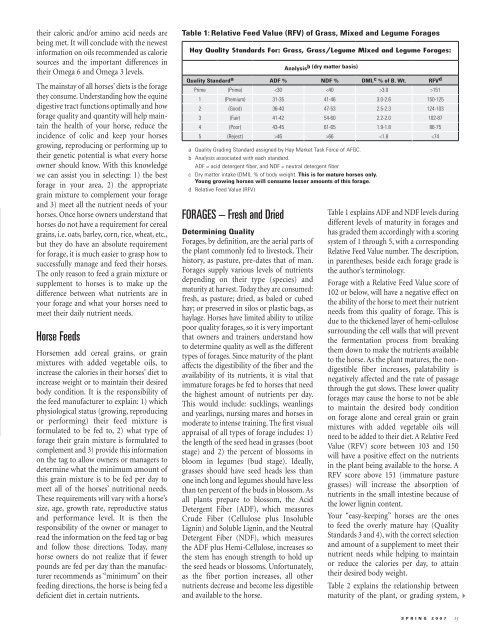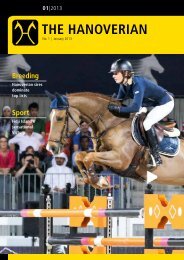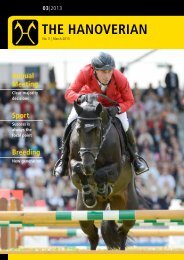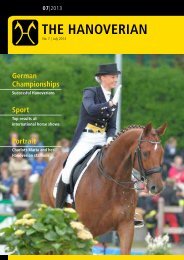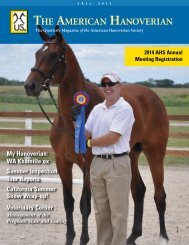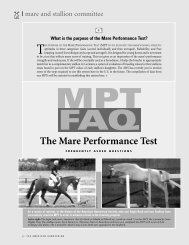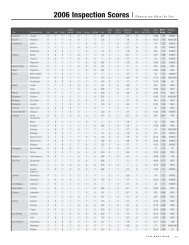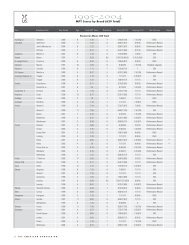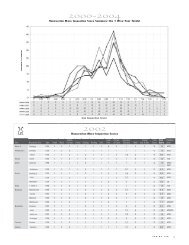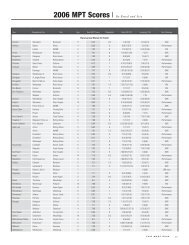Nutrition of the Growing Hanoverian - the American Hanoverian ...
Nutrition of the Growing Hanoverian - the American Hanoverian ...
Nutrition of the Growing Hanoverian - the American Hanoverian ...
Create successful ePaper yourself
Turn your PDF publications into a flip-book with our unique Google optimized e-Paper software.
<strong>the</strong>ir caloric and/or amino acid needs are<br />
being met. It will conclude with <strong>the</strong> newest<br />
information on oils recommended as calorie<br />
sources and <strong>the</strong> important differences in<br />
<strong>the</strong>ir Omega 6 and Omega 3 levels.<br />
The mainstay <strong>of</strong> all horses’ diets is <strong>the</strong> forage<br />
<strong>the</strong>y consume. Understanding how <strong>the</strong> equine<br />
digestive tract functions optimally and how<br />
forage quality and quantity will help maintain<br />
<strong>the</strong> health <strong>of</strong> your horse, reduce <strong>the</strong><br />
incidence <strong>of</strong> colic and keep your horses<br />
growing, reproducing or performing up to<br />
<strong>the</strong>ir genetic potential is what every horse<br />
owner should know. With this knowledge<br />
we can assist you in selecting: 1) <strong>the</strong> best<br />
forage in your area, 2) <strong>the</strong> appropriate<br />
grain mixture to complement your forage<br />
and 3) meet all <strong>the</strong> nutrient needs <strong>of</strong> your<br />
horses. Once horse owners understand that<br />
horses do not have a requirement for cereal<br />
grains, i.e. oats, barley, corn, rice, wheat, etc.,<br />
but <strong>the</strong>y do have an absolute requirement<br />
for forage, it is much easier to grasp how to<br />
successfully manage and feed <strong>the</strong>ir horses.<br />
The only reason to feed a grain mixture or<br />
supplement to horses is to make up <strong>the</strong><br />
difference between what nutrients are in<br />
your forage and what your horses need to<br />
meet <strong>the</strong>ir daily nutrient needs.<br />
Horse Feeds<br />
Horsemen add cereal grains, or grain<br />
mixtures with added vegetable oils, to<br />
increase <strong>the</strong> calories in <strong>the</strong>ir horses’ diet to<br />
increase weight or to maintain <strong>the</strong>ir desired<br />
body condition. It is <strong>the</strong> responsibility <strong>of</strong><br />
<strong>the</strong> feed manufacturer to explain: 1) which<br />
physiological status (growing, reproducing<br />
or performing) <strong>the</strong>ir feed mixture is<br />
formulated to be fed to, 2) what type <strong>of</strong><br />
forage <strong>the</strong>ir grain mixture is formulated to<br />
complement and 3) provide this information<br />
on <strong>the</strong> tag to allow owners or managers to<br />
determine what <strong>the</strong> minimum amount <strong>of</strong><br />
this grain mixture is to be fed per day to<br />
meet all <strong>of</strong> <strong>the</strong> horses’ nutritional needs.<br />
These requirements will vary with a horse’s<br />
size, age, growth rate, reproductive status<br />
and performance level. It is <strong>the</strong>n <strong>the</strong><br />
responsibility <strong>of</strong> <strong>the</strong> owner or manager to<br />
read <strong>the</strong> information on <strong>the</strong> feed tag or bag<br />
and follow those directions. Today, many<br />
horse owners do not realize that if fewer<br />
pounds are fed per day than <strong>the</strong> manufacturer<br />
recommends as “minimum” on <strong>the</strong>ir<br />
feeding directions, <strong>the</strong> horse is being fed a<br />
deficient diet in certain nutrients.<br />
Table 1: Relative Feed Value (RFV) <strong>of</strong> Grass, Mixed and Legume Forages<br />
Hay Quality Standards For: Grass, Grass/Legume Mixed and Legume Forages:<br />
FORAGES – Fresh and Dried<br />
Determining Quality<br />
Forages, by definition, are <strong>the</strong> aerial parts <strong>of</strong><br />
<strong>the</strong> plant commonly fed to livestock. Their<br />
history, as pasture, pre-dates that <strong>of</strong> man.<br />
Forages supply various levels <strong>of</strong> nutrients<br />
depending on <strong>the</strong>ir type (species) and<br />
maturity at harvest. Today <strong>the</strong>y are consumed:<br />
fresh, as pasture; dried, as baled or cubed<br />
hay; or preserved in silos or plastic bags, as<br />
haylage. Horses have limited ability to utilize<br />
poor quality forages, so it is very important<br />
that owners and trainers understand how<br />
to determine quality as well as <strong>the</strong> different<br />
types <strong>of</strong> forages. Since maturity <strong>of</strong> <strong>the</strong> plant<br />
affects <strong>the</strong> digestibility <strong>of</strong> <strong>the</strong> fiber and <strong>the</strong><br />
availability <strong>of</strong> its nutrients, it is vital that<br />
immature forages be fed to horses that need<br />
<strong>the</strong> highest amount <strong>of</strong> nutrients per day.<br />
This would include: sucklings, weanlings<br />
and yearlings, nursing mares and horses in<br />
moderate to intense training. The first visual<br />
appraisal <strong>of</strong> all types <strong>of</strong> forage includes: 1)<br />
<strong>the</strong> length <strong>of</strong> <strong>the</strong> seed head in grasses (boot<br />
stage) and 2) <strong>the</strong> percent <strong>of</strong> blossoms in<br />
bloom in legumes (bud stage). Ideally,<br />
grasses should have seed heads less than<br />
one inch long and legumes should have less<br />
than ten percent <strong>of</strong> <strong>the</strong> buds in blossom. As<br />
all plants prepare to blossom, <strong>the</strong> Acid<br />
Detergent Fiber (ADF), which measures<br />
Crude Fiber (Cellulose plus Insoluble<br />
Lignin) and Soluble Lignin, and <strong>the</strong> Neutral<br />
Detergent Fiber (NDF), which measures<br />
<strong>the</strong> ADF plus Hemi-Cellulose, increases so<br />
<strong>the</strong> stem has enough strength to hold up<br />
<strong>the</strong> seed heads or blossoms. Unfortunately,<br />
as <strong>the</strong> fiber portion increases, all o<strong>the</strong>r<br />
nutrients decrease and become less digestible<br />
and available to <strong>the</strong> horse.<br />
Analysisb (dry matter basis)<br />
Quality Standard a ADF % NDF % DMI, c % <strong>of</strong> B. Wt. RFV d<br />
Prime (Prime) 151<br />
1 (Premium) 31-35 41-46 3.0-2.6 150-125<br />
2 (Good) 36-40 47-53 2.5-2.3 124-103<br />
3 (Fair) 41-42 54-60 2.2-2.0 102-87<br />
4 (Poor) 43-45 61-65 1.9-1.8 86-75<br />
5 (Reject) >46 >66


